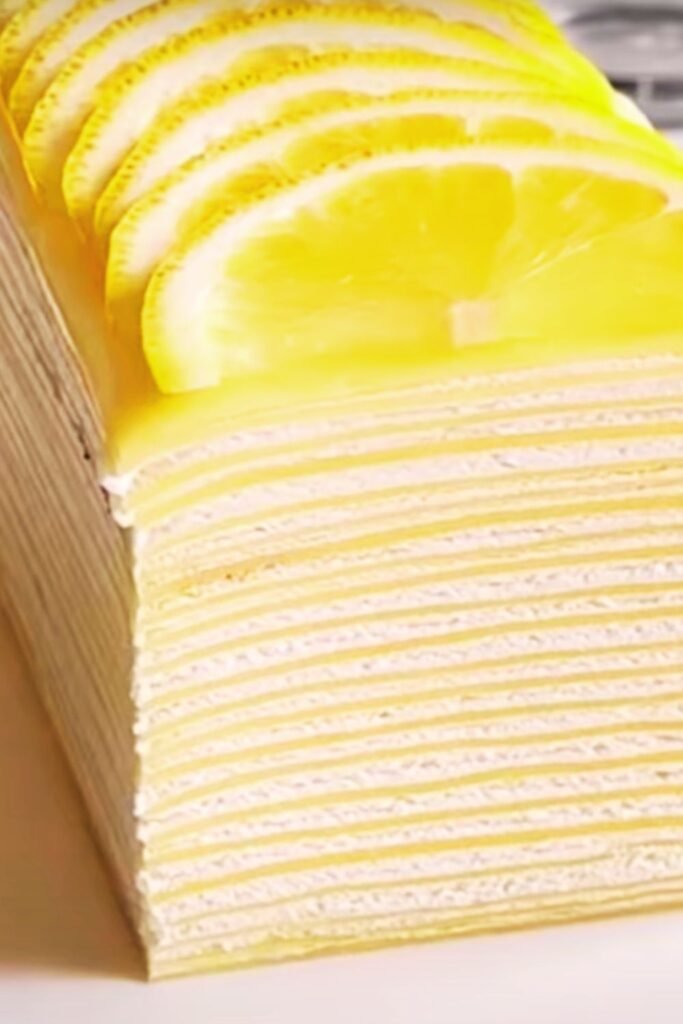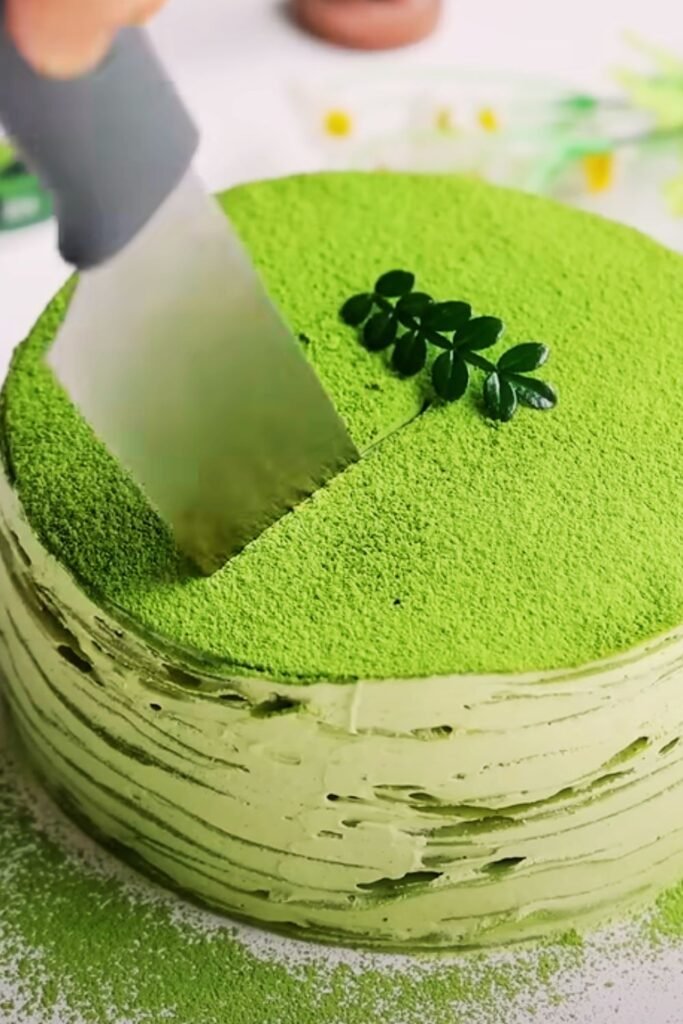There’s something magical about the combination of delicate crepes and bright, tangy lemon cream. When these elements come together in a towering masterpiece known as a Lemon Crepe Cake, the result is nothing short of extraordinary. I’ve been perfecting this recipe for years, and I’m thrilled to finally share my tried-and-true method for creating this show-stopping dessert that’s sure to impress at any gathering.
The beauty of this cake lies in its elegant simplicity. Thin, tender crepes are stacked with layers of velvety lemon cream, creating a dessert that’s visually stunning yet surprisingly straightforward to make. The fresh, vibrant flavors make it perfect for spring and summer celebrations, though I find myself craving this sunny treat year-round.
What Makes This Lemon Crepe Cake Special
Before diving into the recipe, let me share what sets this particular lemon crepe cake apart from others you might have tried:
- Perfect Balance of Flavors: The zingy lemon cream strikes the ideal balance between sweet and tart
- Make-Ahead Friendly: Most components can be prepared in advance, making assembly stress-free
- Customizable Layers: You can adjust the number of crepes based on the height you desire
- Show-Stopping Presentation: Few desserts elicit the same “wow” factor when presented at the table
- Surprisingly Approachable: Despite its impressive appearance, the techniques are manageable for home bakers
Essential Ingredients
Let’s break down the key ingredients you’ll need for both the crepes and the luscious lemon filling:
For the Crepes:
- 2 cups all-purpose flour
- 4 large eggs
- 2½ cups whole milk
- ¼ cup granulated sugar
- 4 tablespoons unsalted butter, melted
- 1 teaspoon vanilla extract
- ¼ teaspoon salt
- Zest of 1 lemon
For the Lemon Cream:
- 5 large eggs
- 1½ cups granulated sugar
- ¾ cup freshly squeezed lemon juice (about 4-5 lemons)
- Zest of 3 lemons
- Pinch of salt
- 1½ cups unsalted butter, softened and cut into tablespoons
- 2 cups heavy cream
- ¼ cup powdered sugar
- 1 teaspoon vanilla extract
For Garnish:
- Fresh berries (raspberries, blueberries, or strawberries)
- Fresh mint leaves
- Candied lemon slices
- Powdered sugar for dusting
Essential Equipment
To ensure success, gather these kitchen tools before starting:
- 8-inch non-stick skillet or crepe pan
- Blender or food processor
- Fine mesh sieve
- Stand mixer or hand mixer
- Rubber spatula
- Offset spatula (for spreading the cream)
- Cake stand or serving plate
- Pastry brush
- Digital thermometer (for the lemon curd)
- Microplane zester
- Citrus juicer
The Crepe-Making Process
The foundation of this spectacular dessert is perfectly thin, tender crepes. Here’s my foolproof method:
- Prepare the Batter: In a blender, combine eggs, milk, melted butter, sugar, vanilla, and lemon zest. Blend for 10 seconds. Add flour and salt, then blend until smooth, about 20-30 seconds more.
- Rest the Batter: Transfer the batter to a container, cover, and refrigerate for at least 1 hour (or overnight). This resting period allows the flour to fully hydrate and the bubbles to dissipate, resulting in more tender crepes.
- Cook the Crepes: Heat an 8-inch non-stick skillet or crepe pan over medium heat. Lightly brush with melted butter. Pour about ¼ cup of batter into the center of the pan, then immediately tilt and swirl the pan to spread the batter in a thin, even layer.
- Perfect the Technique: Cook until the edges look dry and start to curl slightly, about 1-2 minutes. Use a thin spatula to gently flip the crepe, then cook for another 30 seconds on the second side.
- Stack and Cool: Transfer each finished crepe to a plate, placing a small piece of parchment paper between each layer. You’ll need 20-25 crepes total, so patience is key!

Creating the Luscious Lemon Cream
The star of this cake is undoubtedly the lemon cream—a magical hybrid between lemon curd and whipped cream that provides both structure and flavor.
Step 1: Make the Lemon Curd Base
- In a heatproof bowl, whisk together eggs, sugar, lemon juice, lemon zest, and salt.
- Set the bowl over a pot of simmering water (double-boiler method), ensuring the bottom doesn’t touch the water.
- Whisk constantly until the mixture thickens and reaches 170°F on a thermometer, about 10-15 minutes. It should coat the back of a spoon.
- Remove from heat and strain through a fine-mesh sieve into a clean bowl to remove any cooked egg bits and the zest.
- Allow to cool for about 10 minutes, until the temperature drops to about 140°F.
Step 2: Incorporate the Butter
- With a stand mixer fitted with the whisk attachment, begin adding softened butter to the warm lemon curd, one tablespoon at a time.
- Continue beating until all butter is incorporated and the mixture is light and fluffy, about 5 minutes.
- Transfer to a container, press plastic wrap directly onto the surface, and refrigerate until completely chilled, at least 2 hours or overnight.
Step 3: Finish the Lemon Cream
- When ready to assemble the cake, whip the heavy cream with powdered sugar and vanilla until stiff peaks form.
- Gently fold the whipped cream into the lemon curd base in three additions, being careful not to deflate the mixture.
Assembly Tips for a Perfect Crepe Cake
Now comes the fun part—building your masterpiece! Follow these steps for a stunning result:
- Prepare Your Base: Place a crepe on your serving plate or cake stand.
- Begin Layering: Using an offset spatula, spread a thin layer (about 2-3 tablespoons) of lemon cream evenly over the crepe, leaving a tiny border around the edge.
- Continue Building: Place another crepe on top and repeat the process, creating alternating layers of crepes and lemon cream.
- Create Height: Continue until you’ve used all your crepes, ending with a crepe on top.
- Chill to Set: Refrigerate the assembled cake for at least 2 hours or overnight to allow the layers to meld together.
- Final Touches: Just before serving, dust the top with powdered sugar and decorate with fresh berries, mint leaves, and candied lemon slices.

Common Challenges and How to Overcome Them
| Challenge | Cause | Solution |
|---|---|---|
| Lumpy crepe batter | Inadequate mixing | Use a blender or food processor for smooth incorporation |
| Tearing crepes | Too hot pan or trying to flip too early | Ensure medium heat and wait for edges to curl before flipping |
| Runny lemon cream | Not cooking curd to proper temperature | Use a thermometer and ensure it reaches 170°F |
| Curdled lemon cream | Adding butter to hot curd | Allow curd to cool to 140°F before adding butter |
| Uneven cake layers | Inconsistent cream application | Use an offset spatula and measure cream portions |
| Cake slides during assembly | Too much cream between layers | Use a lighter hand with filling and chill frequently |
| Soggy crepes | Filling too wet or assembled too far in advance | Ensure cream is properly set and assemble within 24 hours of serving |
| Dome-shaped cake | Natural tendency due to weight and gravity | Gently press down during assembly and use a flat plate on top while chilling |
Make-Ahead and Storage Guidelines
To make this impressive dessert more approachable, here’s a breakdown of what can be prepared in advance:
| Component | Make-Ahead Time | Storage Method | Notes |
|---|---|---|---|
| Crepe batter | Up to 2 days | Refrigerated in airtight container | May need to thin slightly with milk before cooking |
| Cooked crepes | Up to 3 days | Refrigerated with parchment between layers | Bring to room temperature before assembly |
| Lemon curd base | Up to 1 week | Refrigerated in airtight container | Allow to soften slightly before folding with cream |
| Assembled cake (unfrosted) | Up to 24 hours | Refrigerated, loosely covered | Add final garnishes just before serving |
| Fully decorated cake | Up to 4 hours | Refrigerated | Best consumed day of assembly |
Variations to Try
Once you’ve mastered the basic recipe, consider these delicious variations:
Flavor Twists:
- Meyer Lemon: Use Meyer lemons for a sweeter, more floral flavor profile
- Lemon-Blueberry: Fold fresh blueberries into some of the cream layers
- Lemon-Lavender: Add 1 teaspoon of culinary lavender to the cream
- Lemon-Raspberry: Add a thin layer of raspberry preserves between some layers
- Lemon-Thyme: Infuse the cream with fresh thyme sprigs
Structural Variations:
- Mini Cakes: Use a smaller pan to create individual-sized crepe cakes
- Chocolate Crepes: Add 2 tablespoons of cocoa powder to the crepe batter for a chocolate-lemon combination
- Torched Finish: Sprinkle the top with sugar and torch for a crème brûlée effect
- Naked Sides: Leave the edges unfrosted for a rustic look
- Matcha Accent: Dust alternating layers with matcha powder for a dramatic color effect

Serving Suggestions
A slice of this lemon crepe cake is divine on its own, but you can elevate the experience with these accompaniments:
- Fresh macerated berries
- Lemon sorbet
- Warm tea (Earl Grey pairs beautifully with lemon)
- Fresh mint-infused water
- Sparkling water with a lemon twist
- Iced coffee for a refreshing contrast
- Chamomile tea for an herbal pairing
Nutrition Information
For those watching their intake, here’s the approximate nutritional breakdown per slice (assuming 12 slices per cake):
| Nutrient | Amount |
|---|---|
| Calories | 485 |
| Total Fat | 32g |
| Saturated Fat | 19g |
| Cholesterol | 210mg |
| Sodium | 115mg |
| Total Carbohydrates | 42g |
| Dietary Fiber | 1g |
| Sugars | 28g |
| Protein | 8g |
Note: Values are approximate and may vary based on specific ingredients used.
Expert Tips for Success
After making this cake countless times, I’ve gathered these nuggets of wisdom:
- Temperature Matters: Ingredients at room temperature blend more smoothly.
- First Crepe Rule: Accept that the first crepe might be a practice run—it rarely turns out perfect.
- Consistent Sizing: Use a measuring cup or ladle for the batter to ensure uniform crepes.
- Level Check: Place a toothpick through the center of your cake occasionally during assembly to check that it’s level.
- Chill Between Steps: If your kitchen is warm, consider chilling the cake briefly during assembly to maintain structure.
- Cutting Technique: Use a sharp, thin knife dipped in hot water and wiped clean between cuts for the cleanest slices.
- Visual Appeal: When layering, occasionally place a crepe slightly offset to create an interesting visual effect around the edges.
- Flavor Development: The cake tastes even better after 8-12 hours in the refrigerator as the flavors meld.

Troubleshooting Guide
Even experienced bakers encounter challenges. Here’s how to address common issues:
Issue: Crepes are too thick
Solution: Thin the batter with a little more milk, 1 tablespoon at a time.
Issue: Lemon cream is too tart
Solution: Add an extra tablespoon or two of powdered sugar to the whipped cream component.
Issue: Cake is sliding during assembly
Solution: Chill for 20 minutes midway through assembly to stabilize, and use less cream between layers.
Issue: Crepes are sticking to the pan
Solution: Ensure your pan is properly heated before adding batter, and consider using a bit more butter to grease the pan.
Issue: Lemon curd is lumpy
Solution: Strain it again through a fine-mesh sieve while still warm.
Issue: Cake looks lopsided
Solution: During the chilling process, place a flat plate on top with a lightweight object to gently press and even it out.
Frequently Asked Questions
Q: Can I make this cake gluten-free? Yes! You can substitute a 1:1 gluten-free flour blend for the all-purpose flour. The texture will be slightly different, but still delicious.
Q: How far in advance can I make this cake? For best results, assemble the cake no more than 24 hours before serving. However, the components (crepes and lemon curd) can be made up to 3 days ahead.
Q: Can I freeze this cake? While technically possible, I don’t recommend freezing the assembled cake as the texture of the cream can change upon thawing. You can freeze the crepes alone for up to 1 month.
Q: How many crepes do I need? For an impressive height, aim for 20-25 crepes. However, even 15-18 crepes will create a beautiful cake.
Q: What if I don’t have a crepe pan? A regular 8-inch non-stick skillet works perfectly fine! The key is using a pan with low sides for easy flipping.
Q: Can I use bottled lemon juice? Fresh is significantly better for this recipe as bottled juice lacks the vibrant flavor and can have a metallic taste that becomes concentrated in the curd.
Q: Why did my lemon curd never thicken? The most common reason is insufficient cooking time or heat. Make sure you’re cooking until the mixture reaches 170°F and coats the back of a spoon.
Q: How do I prevent my crepes from tearing? Make sure your pan is properly heated, use enough butter to coat the surface, and wait until the edges are slightly dry before attempting to flip.
Q: Can I make this with other citrus fruits? Absolutely! Orange, lime, or grapefruit would all work beautifully using the same method. Just adjust the sugar to account for the natural sweetness of the fruit.
Q: My cake doesn’t look as tall as in the pictures. What went wrong? The height depends on how many crepes you use and how thick your cream layers are. For a taller cake, make more crepes and keep the cream layers thin but even.
Why You’ll Love This Recipe
I believe this lemon crepe cake is worth every minute of effort because:
- It transforms simple ingredients into something extraordinary
- The make-ahead components reduce day-of stress
- The presentation always impresses guests
- It offers a lighter alternative to traditional layer cakes
- The bright lemon flavor provides a refreshing end to any meal
- It’s adaptable to seasonal fruits and flavor preferences
- Despite its elegant appearance, it’s surprisingly approachable
The joy on people’s faces when they cut into this beautiful creation—revealing the dozens of delicate layers—makes the process deeply rewarding. And when they taste that perfect harmony of tender crepes and luscious lemon cream? Pure magic.
So gather your ingredients, set aside some time for this delightful kitchen project, and prepare to create a dessert that will become a requested favorite for special occasions. Your efforts will be rewarded with not just a gorgeous dessert, but also the satisfaction of mastering a show-stopping technique that you can adapt and make your own for years to come.
Your Questions Answered
Q: I’m intimidated by making crepes. Is there a shortcut? While homemade crepes are best, you could use store-bought crepes as a time-saver. However, they’re often thicker and may affect the final texture of your cake.
Q: How many lemons will I need for this recipe? Plan on purchasing 7-8 medium-sized lemons: 4-5 for juicing and 3-4 for zesting.
Q: Why does the lemon curd need to be strained? Straining removes any bits of cooked egg and the zest, ensuring a silky-smooth texture in the final cream.
Q: Can I add food coloring to enhance the yellow color? You can, but I prefer the natural pale yellow color. If using food coloring, add just a tiny drop of yellow to the lemon curd portion.
Q: What’s the best way to transport this cake to an event? Chill the cake thoroughly, then transport in a cake carrier with ice packs. Keep it refrigerated until about 20-30 minutes before serving.
Q: Do I need a stand mixer for this recipe? While a stand mixer makes the process easier, especially for the lemon cream, a hand mixer will work fine too. Just be prepared for a bit more arm exercise!
Q: Can I reduce the sugar in this recipe? You can reduce the sugar in the crepes slightly, but I wouldn’t recommend reducing it in the lemon curd as the sugar provides both sweetness and structure.
Q: What if I can’t find fresh lemons? In a pinch, you could use a combination of bottled lemon juice and dried lemon zest, but the flavor won’t be as vibrant. I strongly recommend waiting until you can source fresh lemons.
Q: How do you get such clean slices when cutting the cake? Use a long, thin knife dipped in hot water and wiped clean between each cut. Cut with a gentle sawing motion rather than pressing down.
Q: Is this suitable for a wedding or celebration cake? Absolutely! This makes a stunning alternative to traditional layer cakes for weddings or special celebrations. Just be mindful of keeping it refrigerated until shortly before serving.
Whether you’re making this lemon crepe cake for a special occasion or simply to treat yourself to something extraordinary, I hope you enjoy both the process and the delicious result. Happy baking!